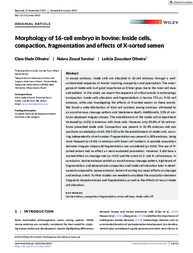Morphology of 16-cell embryo in bovine: Inside cells, compaction, fragmentation and effects of X-sorted semen.
Morphology of 16-cell embryo in bovine: Inside cells, compaction, fragmentation and effects of X-sorted semen.
Author(s): OLIVEIRA, C. S.; SARAIVA, N. Z.; OLIVEIRA, L. Z.
Summary: In mouse embryos, inside cells are allocated in 16-cell embryos through a well-orchestrated sequence of events involving compaction and polarization. The emergence of inside cells is of great importance as itl later gives rise to the inner cell mass and epiblast. In this study, we report the sequence of critical events in embryology (compaction, inside cells allocation and fragmentation) in bovine 72 h.p.i. 9-16 cell embryos, while also investigating the effects of X-sorted semen on these events. We found a wide distribution of total cell numbers among embryos, attributed to an asynchronous cleavage pattern and blastomere death. Additionally, 13% of embryos displayed irregular shapes. The establishment of the inside cell compartment increased (p < 0.01) in embryos with more cells. However, only 53.8% of 16-cell embryos presented inside cells. Compaction was present in 32.4% embryos and was positively correlated (p = 0.03, OR 3.02) with the establishment of inside cells, occurring independently of cell number. Fragmentation was present in 36% embryos, being more frequent (p = 0.01) in embryos with lower cell numbers. A possible association between irregular shape and fragmentation was considered (p = 0.06). The use of X-sorted semen had no effect on most evaluated parameters. However, it did have a marked effect on cleavage rate (p < 0.01) and the arrest of 2- and 4- cell embryos. In conclusion, bovine embryos exhibit an asynchronous cleavage pattern, high levels of fragmentation, and demonstrate compaction and inside cell allocation later in development compared to mouse embryos. Semen X-sorting has major effects on cleavage and embryo arrest. Further studies are needed to elucidate the association between irregularly shaped embryos and fragmentation, as well as the effects of sex on inside cell allocation.
Publication year: 2024
Types of publication: Journal article
Unit: Embrapa Dairy Cattle
Observation
Some of Embrapa's publications are published as ePub files. To read them, use or download one of the following free software options to your computer or mobile device. Android: Google Play Books; IOS: iBooks; Windows and Linux: Calibre.
Access other publications
Access the Agricultural Research Database (BDPA) to consult Embrapa's full library collection and records.
Visit Embrapa Bookstore to purchase books and other publications sold by Embrapa.

